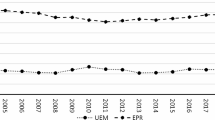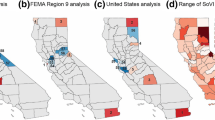Abstract
This paper proposes new fuzzy measures of monetary poverty and also non-monetary deprivation, providing an economic interpretation of the parameters involved. For non-monetary deprivation, the paper provides a step-by-step procedure: dimensions or groupings of initial items of deprivation are identified using explanatory and confirmatory factor analyses, and a weighting system is applied for the aggregation of individual items into the dimension they represent. The methodology is applied to European Union countries using European Union-Statistics on Income and Living Conditions (EU-SILC) data for the 2011 survey wave.


Similar content being viewed by others
Notes
See also Cheli and Betti (1999) and Betti et al. (2002, 2004) for a longitudinal approach to poverty analysis using fuzzy sets, the book of Lemmi and Betti (2006) for further contributions on philosophy, mathematics, economics of the fuzzy set approach to poverty measurement, and the recent contributions of Belhadj (2011, 2012), Alkire and Foster (2011), Belhadj and Limam (2012) and Betti et al. (2013).
The equivalised income of a household is obtained by dividing its total disposable income by the household’s equivalent size computed by using an equivalence scale which takes into account the actual size and composition of the household.
Membership function (m.f.) is a quantitative specification of an individual’s or household’s degree of poverty or deprivation.
The exploratory factor analysis has identified 9 dimensions as follows: items \(b1\), \(b2\), \(b3\), \(b4\) and f1 in dimension 1; items \(g1\), \(g2\) and \(g3\) in dimension 2; items \(d3\), \(d4\) and \(d5\) in dimension 3; items \(c1\) and \(c2\) in dimension 4, items \(a1\), \(a2\), \(a3\), \(a4\) and \(a5\) in dimension 5, items \(h1\), \(h2\), \(i2\) and \(i2\) in dimension 6, items \(e1\), \(e2\) and \(e3\) in dimension 7, items \(g4\) and \(g5\) in dimension 8, and finally items \(d1\) and \(d2\) in dimension 9.
National income distributions have been pooled with weights in proportion to the population size for constructing the EU-level distribution.
The table has been ordered according to this ratio in order to illustrate the point being made.
Regional poverty rates have been computed from regional income distributions, but always using the national poverty line.
By the ‘level of poverty line’ is meant the population level to which the income distribution is pooled for the purpose of defining the poverty line. In fact, different levels for the poverty line can be seen as implying a different mix of ‘relative’ and ‘absolute’ measures. By relative measures is meant measures concerning purely the distribution of income, and by absolute measures those concerning income levels.
References
Aassve A, Betti G, Mazzuco S, Mencarini L (2007) Marital disruption and economic well-being; a comparative analysis. J R Stat Soc Ser A 170(3):781–799
Alkire S, Foster J (2011) Counting and multidimensional poverty measurement. J Public Econ 95(7–8):476–487
Anand S, Sen AK (1997) Concepts of human development and poverty: a multidimensional perspective. Human Development Papers, United Nations Development Programme (UNDP), New York
Atkinson AB (2003) Multidimensional deprivation: contrasting social welfare and counting approaches. J Econ Inequal 1:51–65
Atkinson AB, Bourguignon F (1982) The comparison of multidimensional distributions of economic status. Rev Econ Stud 49:183–201
Atkinson AB, Cantillon B, Marlier E, Nolan B (2002) Social indicators: The EU and social inclusion. Oxford University Press, Oxford
Belhadj B (2011) A new fuzzy unidimensional poverty index from an information theory perspective. Empir Econ 40(3):687–704
Belhadj B (2012) New weighting scheme for the dimensions in multidimensional poverty indices. Econ Lett 116(3):304–307
Belhadj B, Limam M (2012) Unidimensional and multidimensional fuzzy poverty measures: new approach. Econ Model 29(4):995–1002
Berthoud R (2004) Patterns of poverty across Europe. The Policy Press
Betti G, Çalik G, Karakas M (2013) Multidimensional and fuzzy measures of poverty and inequality in Turkey at National and Regional Level. In: Bérenger V, Bresson F (eds) Poverty and social exclusion around the Mediterranean Sea, economic studies in inequality, social exclusion and well-being, vol 9. Springer, New York, pp 89–108
Betti G, Cheli B, Cambini R (2004) A statistical model for the dynamics between two fuzzy states: theory and application to poverty analysis. Metron 62(3):391–411
Betti G, Cheli B, Lemmi A, Verma V (2006) Multidimensional and longitudinal poverty: an integrated fuzzy approach. In: Lemmi A, Betti G (eds) Fuzzy set approach to multidimensional poverty measurement. Springer, New York, pp 111–137
Betti G, D’Agostino A, Neri L (2002) Panel regression models for measuring multidimensional poverty dynamics. Stat Methods Appl 11(3):359–369
Betti G, D’Agostino A, Neri L (2011) Educational mismatch of graduates: a multidimensional and fuzzy indicator. Soc Indic Res 103(3):465–480
Betti G, Gagliardi F, Lemmi A, Verma V (2012) Sub-national indicators of poverty and deprivation in Europe: methodology and applications. Camb J Reg Econ Soc 5(1):149–162
Betti G, Verma V (1999) Measuring the degree of poverty in a dynamic and comparative context: a multi-dimensional approach using fuzzy set theory. In: Proceedings ICCS-VI, vol 11, Lahore, Pakistan, August 27–31, pp 289–301
Betti G, Verma V (2008) Fuzzy measures of the incidence of relative poverty and deprivation: a multi-dimensional perspective. Stat Methods Appl 17(2):225–250
Bourguignon F, Chakravarty SR (2003) The measurement of multidimensional poverty. J Econ Inequal 1:25–49
Cerioli A, Zani S (1990) A fuzzy approach to the measurement of poverty. In: Dagum C, Zenga M (eds) Income and wealth distribution, inequality and poverty. Springer, Berlin, pp 272–284
Chakravarty SR, Mukherjee D, Ranade R (1998) On the family of subgroup and factor decomposable measures of multidimensional poverty. Res Econ Inequal 8:175–194
Cheli B, Betti G (1999) Fuzzy analysis of poverty dynamics on an Italian pseudo panel, 1985–1994. Metron 57:83–104
Cheli B, Lemmi A (1995) A totally fuzzy and relative approach to the multidimensional analysis of poverty. Econ Notes 24:115–134
Duclos JY, Sahn D, Younger SD (2001) Robust multidimensional poverty comparisons. Université Laval, Laval
European Commission (2010) Europe 2020: a European Strategy for smart, sustainable and inclusive growth. Communication No. COM(2010) 2020, European Commission, Brussels
Eurostat (2002) Income, poverty and social exclusion: 2nd Report. Office for Official Publications of the European Communities, Luxembourg
Filippone A, Cheli B, D’Agostino A (2001) Addressing the interpretation and the aggregation problems in totally fuzzy and relative poverty measures. ISER Working Paper Series number 2001–22, University of Essex
Fusco A, Guio AC, Marlier E (2011) Income poverty and material deprivation in European countries. CEPS/INSTEAD Working Paper Series 2011–04, CEPS/INSTEAD
Guio AC (2009) What can be learned from deprivation indicators in Europe? Eurostat methodologies and working paper, Eurostat, Luxembourg
Klir GJ, Yuan B (1995) Fuzzy sets and fuzzy logic. New Jersey, Prentice Hall
Lemmi A, Betti G (eds) (2006) Fuzzy set approach to multidimensional poverty measurement. Springer, New York
Maasoumi E (1986) The measurement and decomposition of multidimensional inequality. Econometrica 54:771–779
Sen AK (1999) Development as freedom. Oxford University Press, Oxford
Townsend P (1979) Poverty in the United Kingdom. Allen Lane, Harmondsworth
Tsui K (1985) Multidimensional generalisation of the relative and absolute inequality indices: the Atkinson–Kolm–Sen approach. J Econ Theory 67:251–265
Verma V, Betti G (2011) Taylor linearization sampling errors and design effects for poverty measures and other complex statistics. J Appl Stat 38(8):1549–1576
Whelan CT, Layte R, Maitre B, Nolan B (2001) Income, deprivation and economic strain: an analysis of the European Community Household Panel. Eur Sociol Rev 17:357–372
Zadeh LA (1965) Fuzzy sets. Inf Control 8:338–353
Author information
Authors and Affiliations
Corresponding author
Appendix: List of country names abbreviations
Rights and permissions
About this article
Cite this article
Betti, G., Gagliardi, F., Lemmi, A. et al. Comparative measures of multidimensional deprivation in the European Union. Empir Econ 49, 1071–1100 (2015). https://doi.org/10.1007/s00181-014-0904-9
Received:
Accepted:
Published:
Issue Date:
DOI: https://doi.org/10.1007/s00181-014-0904-9




